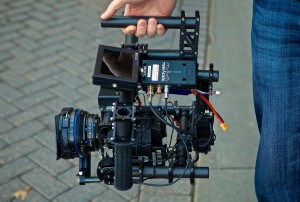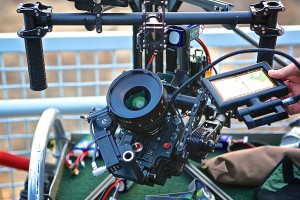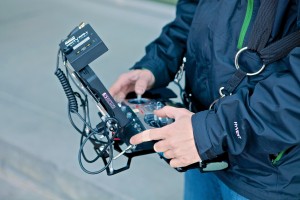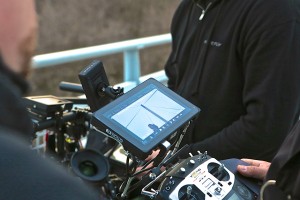MōVI Update – Answers to common question
 So it’s been an amazingly fun week to see the community at large react similarly to the way I did when I first saw the MōVI in action: Amazement.
So it’s been an amazingly fun week to see the community at large react similarly to the way I did when I first saw the MōVI in action: Amazement.
A few notes about the MōVI Short:
There was ZERO post stabilization applied of any kind – you’re seeing the original untouched clips. We did shoot at 4K and had we post stabilized one can imagine how much more smooth they might have looked.
The final film was graded by Andrew Francis at C03 in NYC and he added a film grain emulation – ergo the noise. The short was shot at 3200-4000 ISO at T 1.3 and I don’t remember seeing a hint of noise on the original – you can see for yourself by downloading the original files here.
Here are some basics:
 The MōVI M10 is meant to support up to 10 lbs of weight total. Therefore, you’ll have absolutely no problem running with a DSLR, C300, F5/55 etc and a stabdard Cine Lens.
The MōVI M10 is meant to support up to 10 lbs of weight total. Therefore, you’ll have absolutely no problem running with a DSLR, C300, F5/55 etc and a stabdard Cine Lens.
Tabb Firchau (one of the MōVI creators) and I shot a commercial together last week and we shot the entire spot with a RED Epic (without a side handle,) a somewhat heavy Canon Cine 24mm T 1.3 Prime, Circular ND filtration, follow focus and wireless video. Basically it was a dream. The included batteries will operate the MōVI for 4 hours and a RED Epic for 30-45 minutes at a time.
The MōVI M10 will retails for approx. $15,000 and will include the MōVI, a remote control (joystick similar to what you use for piloting RC Helicopters) and enough batteries to work for a full day.
The MōVI M10 will support two modes: Solo operator mode or “Majestic” (Patent Pending) mode where the MōVI is able to distinguish between erratic movements and user input – i.e. you can pan and tilt your camera SOLO.
The MōVI M10 will also support the use of the included Remote control of course so that you can do the same fancy moves we did on “MōVI.” This is a highly reliable remote that they use to control their RC Choppers at relatively long distances.
The second model is the MōVI M5 – which as its name suggests will support 5 pounds that will retail for $7,500 and include the remote and batteries as well. It will operate in SOLO “Majestic” mode and with dual operator mode just as with the unit above.
The third model: the MōVI M20 is intended for the Alexa M camera and for Epics and other heavier cameras with zooms. Freefly is going to ramp up production on the first two models and then offer the M20 thereafter.
The M10 models are already under production btw… There will be a $3,000 refundable deposit taken to ensure your place in line. (MORE
Now to some general things you need to know about the MōVI:
First you will have two choices on how to operate one, as mentioned above:
“Majestic” (Patent Pending) or Solo Mode where you can just run out and go! (and Pan & Tilt solo.) Figuring this out took a tremendous amount of engineering. If you think about it: how is the MōVI supposed to know if you’re hitting a bump or asking it to Pan or Tilt?)
 Second you will have the option to work with a second operator who is controlling pan, tilt and roll with the joystick which truly allows the person running with the MōVI to concentrate on his/her surroundings, while the second operator on the joysticks fine tunes the framing. This is a dream come true for any DP/Director who’s ever worked w/ a great Steadicam operator but was powerless to make even the slightest change in framing during a shot… It obviously also allows for some pretty darn impressive moves. The joystick offers variable speeds as well in terms of pan and tilt which is extremely useful depending on whether or not your want fine adjustments or whip pans – and yes you can change back and forth with the flick of a switch in the middle of a move.
Second you will have the option to work with a second operator who is controlling pan, tilt and roll with the joystick which truly allows the person running with the MōVI to concentrate on his/her surroundings, while the second operator on the joysticks fine tunes the framing. This is a dream come true for any DP/Director who’s ever worked w/ a great Steadicam operator but was powerless to make even the slightest change in framing during a shot… It obviously also allows for some pretty darn impressive moves. The joystick offers variable speeds as well in terms of pan and tilt which is extremely useful depending on whether or not your want fine adjustments or whip pans – and yes you can change back and forth with the flick of a switch in the middle of a move.
Users will either have to revert to wideangle lenses, or the use of hyperfocal to keep things in focus – or rely on a first AC with a wireless follow focus. We had an AMAZING 1st AC on MōVI named Glen Chin who shot the whole short at T1.3… You will not be able (although I’m sure some will try!) to adjust focus while you move without a wireless focus system. It’s EXACTLY the same deal as using a Steadicam operator – the rule with steadicams is to NEVER touch the camera. While the MōVI is more forgiving as it relies on motors rather than physics to balance – wireless follow focus is highly recommended in order to achieve more complex move when the subject to camera distance varies a lot. The good news is that these systems such as the RedRock Microremote wireless follow focus systems are becoming incredibly affordable relative to what they were just a few years ago.
Speaking of Steadicams – the only thing that they have with the the MōVI is the need to “balance” it. The idea is that if you camera isn’t balanced on all three axes – the motors will have to fight the weight. Therefore if you’ve ever been on set and seen the time it takes (5-15 minutes) for a Steadicam op to configure and balance their system (depending on how many gizmos are on the rig and lenses) you should expect something similar to better with the MōVI. Every time you do a lens change you’ll need a few minutes to rebalance. On average less than 5 minutes. Zooms (especially ones that don’t have big weight changes as they zoom the optic elements) are going to be awesome to use with the system.
In terms of travelling with the unit, it will collapse easily into a carry on size suitcase and weighs less than 3.5 lbs. Sexy.
 Steadicams are one of the most important inventions in cinema history. The catch is that you have to have a seriously skilled operator with 3+ years of experience to “master” it. I’d say the learning curve for basic moves is a few days, then weeks to months to become proficient and years to become an expert.
Steadicams are one of the most important inventions in cinema history. The catch is that you have to have a seriously skilled operator with 3+ years of experience to “master” it. I’d say the learning curve for basic moves is a few days, then weeks to months to become proficient and years to become an expert.
I’ve been given lessons by an expert Steadicam Operator (now DP) Charles Papert and he told me I had a knack for it – but I quickly knew I needed a serious physical regime change to even joke about doing that as a living… I’ve also had previous experience with Cineflex systems and controls (in helicopters) as well as Russian Arms (Car systems) and was able to pick up the control of this MōVI system in a few minutes as a result. Within hours I was proficient. Within a few days I would consider myself a strong user of the MōVI system. For those of you who have wasted hundreds of hours playing video games or with flight simulators: you will finally find that that wasted time will actually become a bona fide “skill set.” 😉
Therefore the learning curves on this system is hours, to days to months depending on how good you are with joystick and situational awareness.
What you’re paying for:
I mentioned the price and justified it in my initial post because I DO truly believe that I understand the realities of market out there. For high end filmmakers this price is literally a STEAL. For people starting out – it’s going to stretch their pocket books for sure. But as with all things the reason I’ve called this device “a game changer” – the first time in 5 years I’ve used the term – is because of where I see this going long term. Remember: the 5D MKII was a bit of a nightmare when it came out for productions due to the lack of available accessories at the time and my arch nemesis: min-HDMI out! (@##@!!!)
But here are two key factors you should really consider:
1. The amount of time you will save in production or on set will be cut significantly by this device. I can do locked off shot (sticks) pushes/pulls/dolly moves (sliders and dollies), boom up or down (Jib) and go on vehicles, boats and helicopters (extremely expensive Gyro systems) and of course Steadicam moves.
ALL with the same device.
More importantly it can do those in a fraction of the time. It literally takes more time to discuss those moves than to actually do them. Working with a second operator can be quite intuitive and freeflowing. You all know how long it takes to do even a simple slider shot between finding the correct height, setting sticks, and practicing the move a few takes: a minimum of a few minutes to do even the smallest of moves. You’re talking SECONDS with the MōVI and I’m not exaggerating.
On a recent commercial my producer was skeptical of the MōVI and how it could save time. When he saw us produce a move that would have previously required a Technochrane or a jib on track to pull off, and we did it in under 45 seconds of unrehearsed moves … well he became a convert in: 45 seconds. We found ourselves ahead of schedule the entire shoot. The point is: you have more time to finesses you moves, make more complex ones, or God forbid tweak your lighting or work on performance. And guys and gals – that pays for the MōVI in less than a day alone.
2. When you add up the price of the sticks, fluid heads, sliders, jibs, steadicams etc – and divide that by 3-4 … they’re still more expensive than one MōVI. And while I ABSOLUTELY not staying the MōVI is meant to replace those – the point is that it can if you want it to.
Ok so that’s it for now. More to come very shortly on how you can order this system.
And if you’ve made it this far – simply follow both @freeflycinema and @vincentlaforet to qualify to win one of two MōVI M10 systems. We’ve got a pretty creative way of selecting the winner… I promise!
Lastly if you’d like to see more footage and donate to a great charity (all the money goes straight to a charity that brings Movies that are currently in theaters to kids who are hospitalized) consider making a donation and downloading new footage shot with a GH3, 3 of the RAW takes from MōVI (including the now infamous job by skater/operator Jon Lyke and the “cab shot”) as well as the full film with director and inventor’s commentary. Heck if you don’t even want to watch it download it or use Vimeo’s Tip Jar on any of the videos to make a donation – ALL OF THE PROCEEDS benefit the kids on behalf of cast and crew.
More to come…













My big question is about getting eye-level shots of taller adults. How does one avoid rapid operator fatigue? It seems that this rig is best for waist and chest-level operation. Is it viable for extended eye-level shooting without additional gear to offload the weight?
We need to use a MoVI to film the “movies” visiting kids in hospitals. Thinking Disney characters in costume stopping by would be pretty epic and awesome. Just an idea!
Think about the extreme sport guys and lugging jibs, sliders, and other gear ontop of a mountain for snow sports. I have tried to skateboard with my glidecam and everytime I push to gain speed to keep up w/ talent I get a giant sway in the footage and thats at 24mm. To think I could only worry about keeping up and let someone else deal w/ focus and framing I could theoretically keep up w/ talent in a pool carving along side them and just point towards the action and let others frame and keep focus. Tons of creative abilities.
Thanks for the update!
(And for anwsering my question in the previous blog about MoVi)
This anwsers most questions, I guess…
Which is convenient since I get questions on Twitter as well after tweeting in Dutch about MoVi, lol.
MoVi seems to awaken new inspiration by filmmakers all over the world. I can’t wait to make a video with it: even if it’s just to try all kinds of shots.
This looks like a great addition to one’s filmmaking kit!
A quick question about the MōVI M5 – is it physically smaller than the M10 or the same size, but only able to support 5 pounds?
Will the M5 be available for pre-order at the same time as the M10?
Do both models include the top handle like the rig you used?
Vincent Laforet Reply:
April 8th, 2013 at 3:10 am
All details to come shortly! Both models will include a top handle. It really just a matter of capacity.
Hello Vincent.
How does the MōVI perform with longer lenses?
Vincent Laforet Reply:
April 8th, 2013 at 3:09 am
We’ve had excellent results with 100mm + lenses.
Hi Mr Laforet,
Its great that personalities such as yourself can showcase the new amazing technologies that are constantly being developed. MōVI looks sure to be every bit the ‘Game Changer’. Oh and BTW, next time your in Hong Kong (like I know you were recently haha), I would love to share your passion for film. Ive followed both freefly and you on twitter so wish me luck!
Vincent Laforet Reply:
April 8th, 2013 at 7:50 am
Ok and good luck!
@Brandon, You need multiple operators. So you could probably switch off to avoid fatigue. If you’re using an Alexa with a heavy Zoom lens though, then it might become a serious problem.
Vincent Laforet Reply:
April 10th, 2013 at 3:48 am
Then you would use the M20 and either an easy rig to steadicam arm.
@Vincent Laforet,
Did you try it at all with an easy rig attached to the movie? In the back of my head this seems like a great way to deal with the fatigue of hand holding the movi. I would love to hear your input on it.
Vincent Laforet Reply:
April 23rd, 2013 at 9:08 pm
It works well – but needs to be refined as the camera sticks out a bit from your body when you hold it out (as opposed to on your shoulders…) v
Hi Vincent,
Hope you’re well?
I have a question regarding The following point :
” “Majestic” (Patent Pending) or Solo mode Pan & Tilt solo.) If you think about it: how is the MōVI supposed to know if you’re hitting a bump or asking it to Pan or Tilt?)”
In fact I don’t really understand (may be because it’s seems magical) how you can Pan or Tilt solo while operating The MoVi? I mean do you have to move a joystick? Is it about The way you move the MoVi? Can you tell us more about this point?
Thank you very much for your reply.
Bye from France 😉
Vincent Laforet Reply:
April 12th, 2013 at 5:13 pm
It knows when you are regularly “pushing” it left so it pans left… and right… and tilts up or down based on steady input from the user. You can also adjust the speed of the pan or tilt. It’s extremely nice. Bonsoir!
@Vincent Laforet, Thank you very much… seems just amazing 🙂
Hi Vincent,
I just landed on the preorder page and i see that movi mr includes an adapter to transform it to movi m10. What does it mean? In which way movi mr package differs from movi m10 excluding that is configured to be placed under the optacopter (i see that they have the same price, so the mr version lack something of the m10 i think)? We are very interested in getting the m10 and we would like to use the system also with the optacopter, but if we buy the optacopter later, will we be able to convert the m10 to mr configuration?
Vincent Laforet Reply:
April 15th, 2013 at 10:17 pm
I know you can go MR to M10 – I need to confirm that you can go M10 to MR. Frankly – unless you’re an EXPERIENCED RC helicopter chopper I would stay far away from them until you have a lot of experience before putting a camera on…
Can we see a simple “Car chase on a Dirt Road” scene ? Even a slow safe 20 mph chase, as long as there are some potholes, rocks, puddles, etc. .
Basically, show the ability of someone wearing a Seat Belt in the back of a Jeep to produce a smooth (but bump filled Shot), like it was filmed from within a ‘chase vehicle’, and yet is easily watchable (a usable Shot).
Presumably a side-by-side with a Steadicam would be best.
Thanks for the great Clips you have provided they look excellent.
Vincent Laforet Reply:
April 15th, 2013 at 6:39 pm
We’ll see what we can do 😉
Hi Vincent,
Is the Movi noisy? Can you record sound while filming with this?
Cheers,
Sabyasachi
Vincent Laforet Reply:
April 16th, 2013 at 12:05 pm
Dead silent – perfect for dialogue.
I am shooting documentaries with a steadicam (pilot), and sometimes have to be able to do it alone. So, how about mounting a conventional form factor camera, like the Sony PMW-200, with a shotgun mic ?
As i see, the Phantom flex cnnot be supported, as to heavy, or with small lenses… Do you know when M20 will be available, or is it in development, and very far ? Any idea of the price ?
Vincent Laforet Reply:
April 27th, 2013 at 7:52 pm
After the M10… not too far after AFAIK
How does the second operator see what they’re doing? Is a wireless monitor system needed or is that included with the Movi’s remote pan/tilt unit?
Vincent Laforet Reply:
May 5th, 2013 at 9:51 am
You will need a wireless system and monitor for the second operator – it is not included w/ the system.